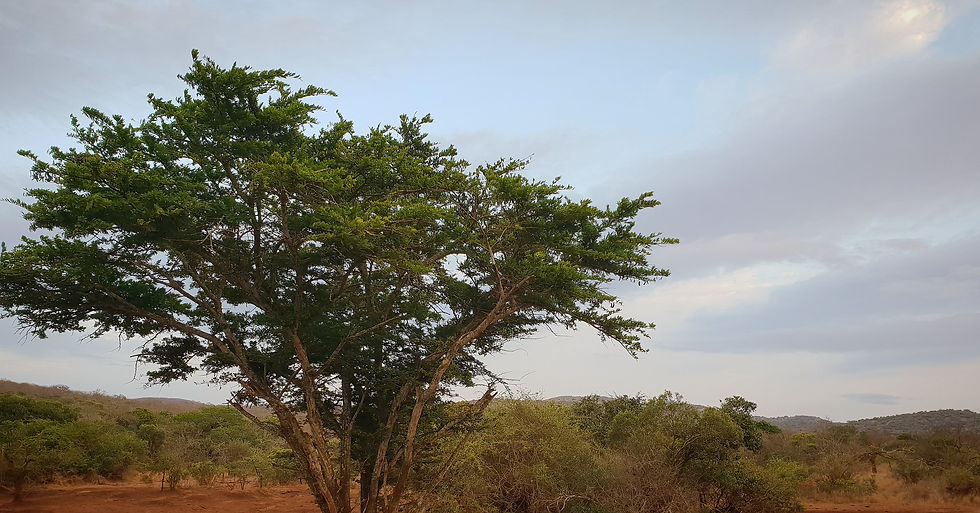Exploring the River Thorn
As we delve into the natural wonders of our world, we often stumble upon species that are not only ecologically significant but also hold a storied history and cultural importance.
One such botanical marvel is the Vachellia robusta, previously known by names such as Acacia robusta.
This impressive tree, belonging to the pea, bean, or legume family (Fabaceae), stands as a testament to nature's resilience and diversity.

The Majestic Form
Typically emerging as a single - stemmed giant, the Vachellia robusta can soar up to 20 m high. Its branches stretch upwards in a nearly vertical display, while its mature bark, a tapestry of grey and black, is deeply fissured, adding to its rugged appearance.
The leaves of this deciduous tree are a spectacle themselves - bipinnate with spaced leaflets adorned with whitish, spiny stipules that catch the eye.
Spring brings a burst of life to the Vachellia robusta as it adorns itself with capitate spikes of flowers. These are not just any flowers; their exserted stamens create a visual dance of colors around the pistil, highlighting the tree’s reproductive prowess.
The fruits of the Vachellia are pods, wide and straight, harboring shiny seeds that are as functional as they are aesthetic.
A Cultural and Ecological Cornerstone
The tree is not just a visual treat but also a cornerstone species in its habitat. It offers food and shelter to various wildlife, from insects that buzz around its flowers to birds that perch on its branches.
The tree's ecological role extends below ground, where it engages in a symbiotic relationship with Rhizobium bacteria, essential for nitrogen fixation, enriching the soil where it stands.
In human culture, the Vachellia robusta has multiple uses. Its wood, though not ideal for fuel due to its propensity to warp, is used in making furniture and for tanning leather, thanks to the tannins in its bark.
The seeds, after some preparation to enhance germination, can bring forth new life, continuing the cycle of growth.

The Name and Its Legacy
The naming of the genus Vachellia traces back to George H. Vachell, a chaplain and plant collector in China, whose contributions to botany are memorialized in the nomenclature.
The subspecies robusta, meaning robust, aptly describes the tree's sturdy and resilient nature.
This tree also holds various common names that reflect its characteristics and the regions it adorns. From "Ankle Thorn" to "Splendid Thorn", each name reveals a facet of its identity or the admiration it commands among those who know it.
Conservation
Presently, Vachellia robusta is classified under the 'Least Concern' category by conservation standards, indicating that it is not at immediate risk of extinction.
This status provides hope and a reminder of the importance of environmental stewardship to ensure that future generations can also appreciate and benefit from this splendid tree.

Conclusion
The Vachellia robusta is more than just a tree. It is a living legacy, an ecological pillar, and a source of beauty and utility in its natural surroundings.
Whether you are a nature enthusiast eager to learn about diverse plant species or someone passionate about conservation, the story of the Vachellia robusta offers insights and inspiration.
About The Author
Kyle Grobler is a passionate environmentalist and esteemed field guide from Potchefstroom. With an unparalleled love for nature, he boasts a vast collection of over 40,000 photos, illustrating his particular affinity for birds.
Known by many as the embodiment of a true bushman, Kyle has ventured through various South African game reserves and frequently explores the Vaal River's hidden treasures. As a new contributor to the Potch Gazette's environmental page, readers can anticipate immersive tales of Potchefstroom's natural wonders through Kyle's expert lens.
To see more from Kyle and his bush experiences you can also view his Youtube Channel here: Kyle Grobler Photography
More Plant Stories
For more articles about plants you can click on the links below, there are so many great plants amongst us to discover and learn about as they play a major role in nature as we see it today.
Commelina Flowers: Click Here
Giant Stapelia: Click Here
Blood Lily: Click Here
Ground Lily: Click Here
Weeping Boer - Bean: Click Here
Fever Tree: Click Here
Giant Euphorbia: Click Here
Wild Olive: Click Here
Flowering Grass: Click Here
River Lily: Click Here
Baobab Tree: Click Here
Marula Tree: Click Here
Paintbrush Lily: Click Here
Tulbaghia: Click Here
Bell Agapanthus: Click Here
Spekboom: Click Here
White Water Lily: Click Here
Jacket Plum: Click Here
Blue Water Lily: Click Here
Weeping Willow: Click Here
Tall White Squill: Click Here
Halfmens: Click Here
Bushveld Candelabra Euphorbia: Click Here
Crane Lily: Click Here
Morning Glory: Click Here
Helichrysum Marginatum: Click Here
Common Coral Tree: Click Here
Cornish Lily: Click Here
Drakensberg Carnation: Click Here
Sour Plum: Click Here
Mountain Aloe: Click Here
Mountain Cabbage Tree: Click Here
Sea Kelp: Click Here
Impala Lily: Click Here
Sycamore Fig: Click Here
Sausage Tree: Click Here
Sea Hibiscus: Click Here
Tamboti Tree: Click Here
Euphorbia Tirucalli: Click Here
Comments, Suggestions, Stories
Please do feel free to add any comments in our comments section below, we always love to hear about animals and experiences from our readers.



.jpeg)
